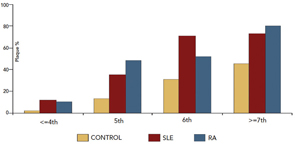We found that RA patients with plaque were more likely to have conventional cardiovascular risk factors (older age, higher LDL cholesterol levels and systolic blood pressure), and more severe RA (longer duration, higher Multidimensional Health Assessment Questionnaire [MDHAQ] score, and a larger number of fixed joint deformities).17
Treatment Patterns and Inflammation Markers
RA treatment was similar in both groups, with the exception of more common use of anti-tumor necrosis factor (TNF) agents in patients with atherosclerosis. Of note, the presence of plaque was not affected by the use of COX-2 inhibitors. Thus, in our studies, more vigorous treatment of SLE patients was associated with lower plaque prevalence, but in RA, the use of anti-TNF agents was associated with higher plaque prevalence.
Our patients’ initial diagnoses of RA antedated the availability of anti-TNF agents (mean duration of disease of 12 ± 10 years), which were added later to the regimens of patients with disease refractory to conventional treatment. The administration of these agents in our study may therefore represent a surrogate marker of disease activity and damage rather than an atherogenic effect of the drug. This interpretation is supported by a higher number of fulfilled RA diagnostic criteria and higher MDHAQ scores in patients who had used anti-TNF agents compared with those who had not.17
Markers of systemic inflammation have been shown to confer increased risk for cardiovascular death in RA suggesting that inflammatory mediators may play a direct role in ASCVD pathogenesis.13,18 We did not find differences in CRP, ESR, IL-6, and circulating adhesion molecules between RA patients without and with atherosclerosis but, as was the case in our lupus study, these circulating inflammatory markers were elevated compared with the normal range.

Both our studies were limited by their cross-sectional design and inherent inability to establish causality rather than document associations. Single determinations of inflammatory markers may not accurately represent concentrations over time and the cumulative burden of exposure. In addition, we were unable to precisely quantify lifetime dosages of medications to examine more fully and accurately the impact of pharmacologic therapy on the development of atherosclerosis.
Although we did not identify a biomarker for atherosclerosis in our patients, we demonstrated an excess of preclinical atherosclerosis in RA and SLE compared to a matched control group, an increase that was most striking in younger individuals. Traditional ASCVD risk factors were not primarily responsible for accelerated atherosclerosis, and corticosteroid therapy was certainly not an atherogenic factor in these patients.
Take Control of Cardiac Risk Management
The evidence for accelerated atherosclerosis in SLE and RA is compelling, yet studies show that rheumatologists are not adequately implementing preventive strategies.19,20 In our study, RA patients with plaque had a mean total cholesterol value of 226 mg/dL, but therapy with lipid-lowering agents was uncommon (approximately 5%).

